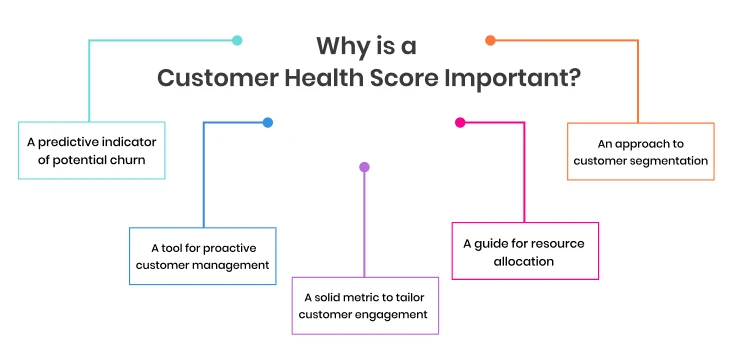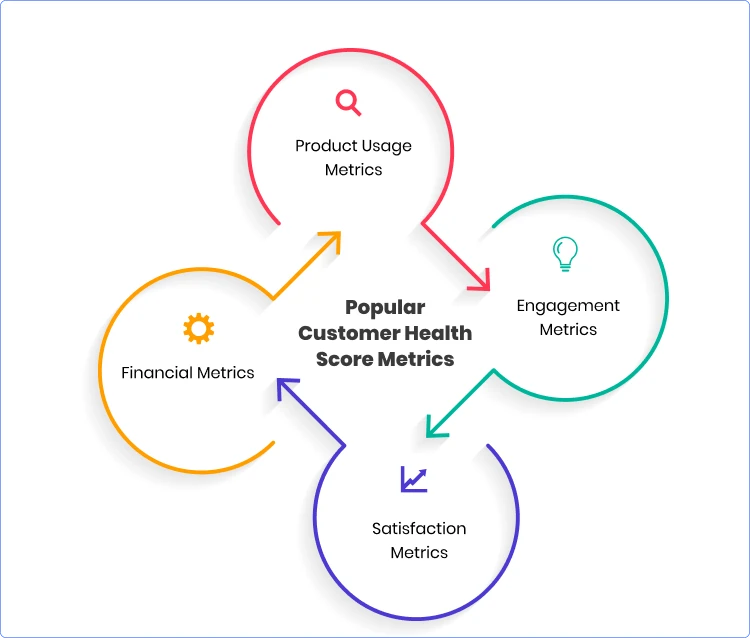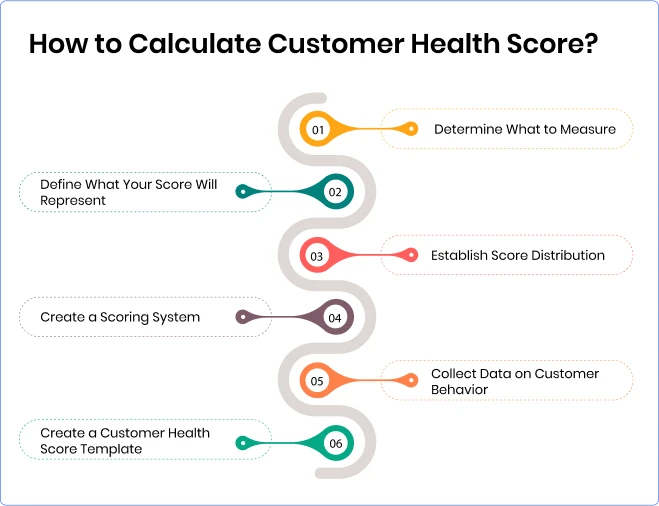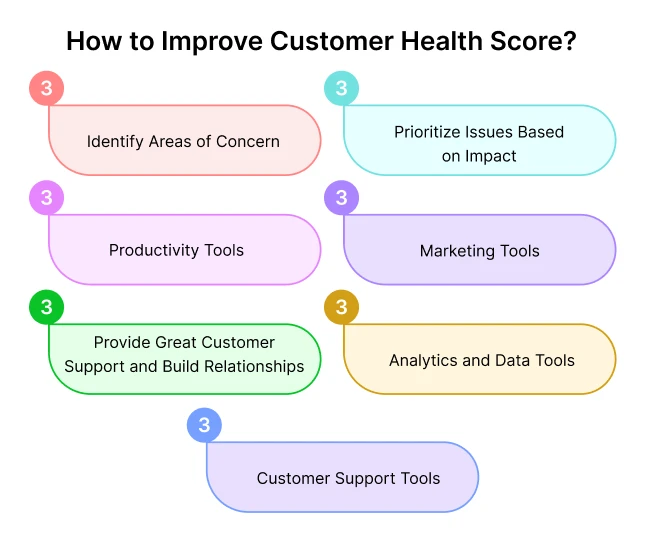What is a Customer Health Score & How to Calculate it?
- March 5, 2024
- 13 mins read
- Listen

Table of Content
A business should routinely check whether its customers are healthy or at risk. If customers are healthy, they are going to stick, make repeat purchases, and contribute to the business revenue. And if they are not, the chances of churn will be higher. And we know most businesses fear churn.
And if customers are not healthy, who knows they might wake up someday and decide to leave, leaving you rattled. You’d surely want to avoid that situation. The key is to know the reasons and actions that may cause the churn.
This is where a customer health score metric comes into the picture.
Tracking this metric can help you –
- Understand the level of customer happiness with your product or service
- Analyze the health score of your business at a particular point in time
- Identify customers who are at risk of churning or disengaging
In this blog, we will explore a customer health score in detail, understand its importance for companies, see some examples, and also look at the tips to increase it.
Before moving further, let’s first get started with the definition.
What is a Customer Health Score?
Customer health score is a powerful metric to measure the risk levels of a customer churn. It is a good indicator of whether a customer is planning to stay or leave. This metric also indicates how robust a relationship the business has with its customers.

The customer health score is a very useful metric for customer service teams and account managers to know whether a customer is at a high or low risk of churn. By tracking this metric, a business can understand ideal candidates for upselling and adjust its sales and marketing efforts accordingly.
The earlier customer success teams measure this score, the more proactive steps they can take to minimize the dangers of churn.
Why is a Customer Health Score Important?
A business should consistently track the customer health score. Doing this can help it identify customers who are likely to go away or stay. When this metric is not measured regularly, a business fails to know how healthily it’s managing customer relationships and ensuring success.
A customer health score is important for various reasons, including –
- To understand customers’ loyalty or churn potential
- To gauge customer engagement with product/service
- To identify happy and unhappy customers
- To know whether customers need immediate support for their issues
- To know whether you can offer your customers additional services or upgrades.
- To allocate the resources judiciously
- To categorize customers into different groups
- To offer personalized experiences based on the needs of each segment
Key Customer Health Score Metrics
There is no specific formula to calculate a customer health score. Businesses that look to calculate it often rely on various metrics, specific to the nature of their industry and the unique customer needs. However, there are some key metrics that you need to measure customer health, and these are –
Product Usage Metrics
Product/service usage gives a healthy peek into user interaction or engagement with your product or service. It helps you understand the various degrees of adoption by users. This metric can suggest how much users are benefiting from your product. To track this metric, you will need information on –
- Login history
- Total time spent in the app
- Engagement with new product features
- Utilization of licensed services
When evaluating product usage, you can consider various aspects, including –
- The average duration a user engages with your product or service
- The variety of features a user utilizes
- The level of reliance on specific features of your product
Engagement Metrics
Engaged customers spend 67% more on average than new ones. This shows why customer engagement level is an excellent indicator of someone’s probability of sticking or leaving. You can track different engagement metrics to understand a customer health score, including –
- Customer satisfaction (CSAT): It’s a commonly used metric that will indicate how satisfied customers are with your products or services. You can measure it through customer feedback and express it as a percentage, ranging from 100% to 0%.
- Net promoter score (NPS): This metric can help you gauge customer loyalty, satisfaction, and enthusiasm with your company. You can calculate it by asking customers one question: “On a scale from 0 to 10, how likely are you to recommend our product/company to others?” Based on responses, you can segment customers into detractors (1-6), passives (7-8), and promoters (9-10).
- Customer lifetime value (CLV): This metric will help you assess the total net profit you can expect to generate from a customer throughout their entire stay. To calculate this metric, you will use parameters like the customer’s initial purchase, repeat purchases, and average stay with your company.
Retention and Churn Rates
Retention and churn rates are good indicators of customer health. These metrics provide information on the chances of a customer’s leaving or staying. Both measure different customer data points.
- Churn Rate – It’s the percentage of customers that leave within a specific time frame.
- Retention Rate – It’s the percentage of customers that stay with you.
Financial Metrics
A business’ financial health improves when customers stay for a longer duration and purchase more. Such behavior is often reflected in the overall performance of the business. That’s why financial metrics provide a solid measure of the customer health score.
- Renewal Rate – It measures the ratio of customers who opt/choose to renew and extend their contracts at the end of a subscription period.
- Revenue Growth – It’s a key metric to measure a percentage increase from a starting point. To calculate it, one has to divide the rate of increase in total revenue by total revenue in the previous year.
How to Calculate Customer Health Score?
The calculation will depend on the type of metrics you use and the type of business you operate. The key is to include both positive and negative indicators as it will give a detailed insight into the health of your customer.
Follow these steps to calculate a customer health score specific to your business –
1. Determine What to Measure
You will need some key indicators to determine the health of a customer. You also need to determine what to measure as it will be unique to your business or product. You can track or measure many things, including –
- How frequently does the customer use a key feature of your product
- How often do they engage with the app, or log into the account
- How many support tickets do they have
No matter what you decide to track, it should suggest the chances of your customers to upgrade or disengage. You can then use it as a factor for your customer health score formula.
2. Define What Your Score Will Represent
The score you get will indicate something about your customer’s health. It can indicate positively or negatively. Whatever it does will help you redefine your customer effort and customer success strategy. The information you seek or use can be key to monitoring the relevant behavior metrics and accurately measuring customer health at any specific point in time.
3. Establish Score Distribution
Make a list of all actions you want to consider for calculating the health score of your customer. There will be positive and negative actions – include both in the formula.
While grouping actions, remember two things –
- Add the positive actions to your score
- Subtract the negative ones
4. Create a Scoring System
Each customer action will have varying degrees of impact on the health score. For this reason, you must assign a score to each action. This will help determine the impact of each action on a customer’s health. While assigning weight, you may also analyze the actions of happy and risky customers, and adjust your score accordingly.
After that, create a scoring system that will give an overall idea of the health of your customer. In the scoring system, show value-addition actions on the positive side and others on the negative side.
5. Collect Data on Customer Behavior
The more customer data you have, the better insights you will gain on the health of your customers. That’s why you need to collect data on consumer behavior and habits to get an accurate picture of customer health. The data you have can help you put customers in different number ranges and set benchmarks.
6. Calculate the Health Score
Now you can use the assigned impact scores and calculate the total health score. Before calculating the score, you also need to tally the total action value for each customer.
Use the below formula –
Customer Health Score (CHS) = Sum of positive action values – Sum of negative action values)
Let’s suppose you have six positive actions and 3 negative actions. Now let us assign the value 5 to a positive action and value 2 to a negative action. ( Note: you can assign any value )
In that case, the CHS would look like that –
CHS = 5×6 – 2×3
CHS = 30 – 6
CHS= 24
How to Improve Customer Health Score?
Engaged and satisfied customers are always the foundation of growth for any business. This is why improving the health of customer relationships directly impacts the customer health score.
Here are different ways to improve the customer health score –
1. Identify Areas of Concern
A business needs to identify the areas of concern that may be causing customer dissatisfaction.
There are two ways to achieve that –
- Reviewing customer data and feedback
- Evaluating support interactions
Identifying weak areas can be a good point for enhancing customer satisfaction and happiness.
2. Prioritize Issues based on Impact
Some issues may be critical and can impact the health of your customer more. If they are not addressed on time, they might push customers toward churn.
You need to remember two things –
- Some issues may not cause an immediate impact but might have a negative effect in the long run
- Prioritize the most critical issues based on the level of impact they have on the customer
3. Focus on Enhancing Product Adoption by Customers
When customers are happy, they are more likely to optimize your product or service’s features fully. You can trust such customers to stick for longer based on the extent of product adoption. That’s why you should always focus on encouraging customers to maximize the value of your offering. You also need to gauge their responses to your messages and communications. That can also be a good signal of their immediate trust in your brand.
4. Engage More with Customers
Engaged customers tend to be more trustful and less fidgety. The more engaged they are, the better relationships they form with the business. Such customers are also more receptive to price fluctuations in products or services. On the other hand, 66% of consumers will abandon a brand if not engaged through personalized experiences.
Here are some key steps to engage more with customers –
- Foster engagement through proactive and personalized communications with the customer
- Make sure you collect regular feedback
- Attend to their queries promptly
- Take steps to meet their needs
5. Provide Great Customer Support and Build Relationships
Customers feel happy and valued when a business provides great support to them. Addressing their issues promptly and always guiding them through their problems is key to avoiding churn. You can win customers for life if you focus on building long-term relationships and align your business goals with theirs.
Make sure you –
- Always focus on meeting customer’s expectations
- Always focus on improving their experience with your brand
6. Talk to customers
Is your customer health score low despite all your good efforts to build customer relationships and offering value? Not sure why? Well, you can speak to customers and get a better understanding of the issue troubling customers. You can think of sending out satisfaction surveys, but that won’t help beyond a point.
Talking to customers means –
- Reach out to customers directly
- Ask them about the issues they are facing
- You can also ask why they are not scoring highly on various survey parameters you have set
- You may also ask them about the steps and actions they expect of you
7. Identify Patterns
Do you think your customers’ behavior is changing towards your products or services but not sure how to find out about that? Consider analyzing all the customer data and insights you have gathered. The analysis can suggest why some features are not getting the kind of traction you expected and so on. The more you dig deep into the data, the more you can find some patterns behind the customer’s unhappiness, resulting in a low customer health score.
Customer Health Score Examples
Interpreting behavioral data and health scores is vital to gaining deep insights about customers. It helps us reach a meaningful conclusion about what customers like and what not. Some businesses are very good at turning the health score data into a decision-making tool.
Here are a few customer health score examples for you –
1. Percentage Scale
This scale is very simple to use and most businesses can adopt it for calculating their customer health scores. Whatever maximum value is assigned for a health score, the customer score can be divided by that value to get a percentage. Using this scale, a percentage score for each action can be calculated which eventually can help you exceed customer expectations.
2. Colour-Coding Scale
This scoring system may not be as precise as the percentage one, but it nonetheless is easy to use. Its working resembles that of a traffic light where the “red color” and “green color” have different meanings. Here too, the health score is assigned three values in color red, yellow, or green for easy understanding of their satisfaction level with the business.
3. Grading-Based Scale
As the name suggests, this scoring system assigns grades from F to A to a range of health scores. Excellent scores are rated A while poor ones are graded F, and the rating follows a top-down approach with the inferior ratings appearing higher and vice versa. The grading system makes it an easy method to understand the health score quickly.
Boost Customer Engagement and Achieve a Better Health Score with REVE
Engaged customers stay for longer, spend more, and have a higher CLV. Keeping this in mind, your business should focus more on engaging with customers more frequently and effectively.
At REVE, we bring you a wide range of engagement and support tools that you can use and serve your customers better.
You can use our AI-powered chatbot to increase the response rate and automate tasks across sales, marketing, and support.
You can also provide better visual support to customers by using our tools such as video chat software and co-browsing software.
Plus, we have advanced live chat software that you can add to the bot and elevate the level of customer support.
Final Thoughts
A business that strives for customer happiness enjoys better retention rates and lower churn. When customers are happy, they don’t feel the need to switch to competitors.
At REVE, we understand the significance of keeping customers engaged and serving them the best you possibly can.
That’s why our tools can be a great value addition to your customer engagement strategy. You can sign up and check the features of our products.







